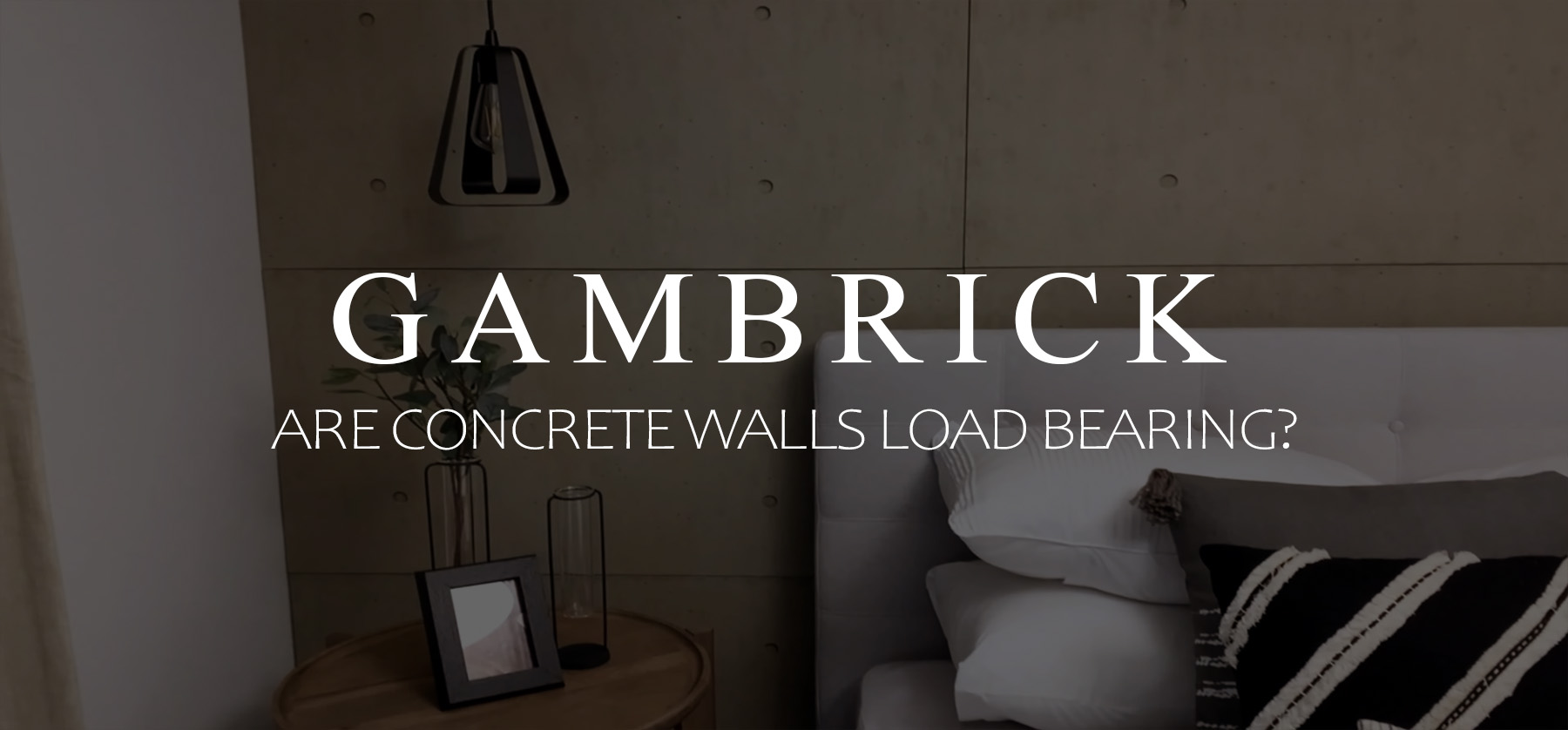
Are Concrete Walls Load Bearing?
Concrete load-bearing walls are designed to support the weight of a floor, roof or other structure built atop them. They’re named load bearing walls because they can support a large amount of weight without failing. By contrast, a non-load-bearing wall, also called a partition wall, is not designed to carry heavy loads. They’re built to hold there own weight and a few other light items like shelves, pictures or interior doors. What helps determine what is and what isn’t a load bearing wall is the wall’s foundation. Load bearing walls are built on strong foundations and non load bearing walls are not. Concrete is one the best materials to build a load bearing wall out of because it has extremely high compressive strength. But not all concrete walls are load bearing.
Home remodeling often requires demolishing a wall or two. Removing walls is a big job that can completely transform a home. If you have remodeling plans that include removing a concrete wall, you must determine whether the wall is load-bearing or non-load-bearing.
Any part of a load-bearing wall that’s removed must be replaced with structural support to take it’s place. This includes beams, footings and columns that can bear the same load that was supported by the wall.
Most concrete walls are load bearing, but not all. These days interior concrete is a very popular finish. Designers are using concrete for its looks and not its strength. To determine whether or not the wall is load bearing, inspect the foundation. Load-bearing walls sit directly on a foundation and footing, non load-bearing walls do not.
The problem with using concrete in Modern homes is that concrete walls block WiFi, which is not standard in almost all homes.
Check The Foundation
The best way to find out if your concrete wall is load bearing, is to check the foundation. Load bearing walls are always built on some sort of support structure. Usually it’s a foundation wall but it could also be a beam. That beam would then be supported by a wall, piers columns that are ultimately supported by footings. Follow the path from your wall down to the earth to understand how it’s supported.
Interior non-load bearing walls are generally not built directly on top of a foundation or beam because they’re not designed to carry much weight. However there are always exceptions. In some cases, an architect may build a concrete wall on a beam or foundation simply to support its own weight. Concrete is a heavy building material which means a thick concrete wall will need support. You can’t simply built it on wooden floor joists because they’ll sag.
Examine the foundation for both walls and columns. If your concrete wall is supported by a beam you’ll need to find the beam’s support columns or masonry piers. Those columns or piers will run down to footings which ultimately support the entire load.
Inspecting a concrete walls foundation doesn’t tell the whole story. Just because the architect built the wall on top of a foundation doesn’t necessarily mean it’s load bearing. To be sure you also have to check what’s directly above the wall.
What’s Above The Wall?
Once you check the foundation to see what supports the concrete wall, look up. Figure out what’s sitting directly on top of the wall. Load bearing means the wall is directly supporting something on top of it. So take a look and see what’s up there.
Does you concrete wall support floor joists, a beam or header, columns, a roof or other structure? The only way to know for sure is to examine the house carefully. Map out what supports all the floor joists, beams, columns, roof and other structures. It’s process of elimination. If you can determine what supports everything in the general area of the concrete wall, then the wall probably isn’t load bearing.
Go into the attic space directly above the wall if there is one. Take a look around and map out the framing. You can tell a lot about a house from examining an attic.
The safest way to find out what’s above your wall is to do a little demo. Cut a hole in the ceiling above the wall and see what’s up there. When the top of the wall is exposed it’ll be easy to tell if it’s load bearing or not.
How Thick Is The Wall?
A good indicator of whether or not your concrete wall is load-bearing is it’s thickness. Load-bearing poured concrete walls and cinder block walls are at least 6 to 12 inches wide. If you have a concrete interior wall that’s 4 or 5 inches wide it’s probably wood or metal studs with a concrete veneer.
However, if you have a concrete wall that’s 6 to 12 inches thick there’s a good chance it’s load-bearing. But not always, in some cases an architect may frame and interior wall extra thick just for appearances. It could also hold duct work and/or plumbing.
Wall thickness is just another clue that can help you determine whether or not a concrete wall is load bearing.
Generally speaking, thin walls are not load bearing, especially in new construction. Modern building code doesn’t allow load bearing walls to be that thin unless they’re built with steel.
Check the joist direction, see what’s directly above the wall, look for signs of a beam, and check the foundation. You need more information that just the wall’s thickness to determine if it’s load-bearing.
Is It An Exterior Concrete Wall?
Exterior walls are walls that form the perimeter of a house. The upper floor joists, roof, windows, doors, beams and headers all rest on exterior walls. In general, almost all exterior concrete walls will be load-bearing, but you should still examine the wall, house framing and foundation to be sure.
Exterior walls generally rest on top of the home’s foundation and support the roof or structure above. I’ve been a custom home builder for over 20 years and almost all the exterior concrete walls I’ve built have been load bearing. But not all.
A house will rarely have a long stretch of a exterior wall that is non-load-bearing. But it’s possible if your using steel framing. Modern houses and many building occasionally use large steel beams and columns to support the entire structure instead of wall sections. Wall sections that sit beneath the steal beams are still built insulated and strong, but are usually not load-bearing.
If you’re working on a house that has steel beam construction, look for columns. Once you find those, the wall sections between the columns usually are not load-bearing. That’s what the columns are for.
Is The Wall Perpendicular Or Parallel To Joists?
Generally, when an interior wall runs perpendicular to the floor joists above, it’s a load-bearing wall. Home are framed in such a way that the ends of the floor joists either sit on an interior wall or a beam, or butt up to a beam. If your concrete wall runs perpendicular to the joists it’s a good clue that it may be load bearing.
If an interior wall runs parallel to the joists, it’s probably not load bearing. Parallel means the wall runs in the same direction as the joists. However, even if the wall isn’t supporting floor joists it could still support a column or beam.
Keep in mind that the relationship between floor joist and interior wall direction is just one clue out of many. There are lots of situations where a wall running parallel with floor joists can still carry a significant load.
Just because a concrete wall may not seam to carry a load doesn’t mean it isn’t. It takes a lot of investigating to figure out for sure.
Is It A Partial Concrete Wall?
Many homes have short walls that are referred to as partial walls. They generally extend off an exterior wall, butting up to the wall at a 90 degree angle. In some cases partial walls are just there to divide two rooms and are not load-bearing. But in other cases they support beams, columns or joists.
If your concrete wall is a partial wall, check out it’s foundation. If the wall sits directly on top of a partial foundation wall it’s probably holding some substantial weight.
Blueprints
Your local county clerk’s office may have a copy of the home’s original blueprints as well as records of any modifications. Previous owners, the builder or architect who designed the house may also have the plans. You township can tell you who the builder and architect were as long as the house isn’t too old.
Older Homes
Working on really old homes is strange because they may have gone through several remodels. I find all sorts of weird things when I start demoing old houses. In some cases, a wall that was once load bearing isn’t anymore because the roof or house frame has been changed. It’s a lot harder to figure out what is and isn’t load bearing when the house is really old. Unless it’s all original.
If the house is an original and has never been remodeled, it’s no different than inspecting a new house. Things only get hard if the house has been remodeled, especially if the remodel wasn’t done legally.
Another common issue are additions. If the house has been added onto, older exterior load-bearing concrete walls may now be interior non load-bearing. You really have to do your homework when working on older homes. I recommend going to the township and requesting a list of work that’s been done along with the original plans. They may have records of all the work.
Hire A Pro
When in doubt, I always recommend hiring a Pro.
There are four types of professionals that can help you determine if the concrete wall is load bearing. These are:
- Architects: If you can find the architect that designed the house it’s much better. He may still have the plans. But if not, any architect can help you figure it out. They can examine the house and draw out all the load points.
- Building Inspectors: An inspector can help locate load-bearing walls as well as inform you of building codes.
- Builder: If you can find the builder of the home it’s a big help, they may still have the plans. But if not they’ll probably remember the wall. I’ve built hundreds of custom homes and I can tell you where every load bearing point is in all of them. It’s not something a builder will usually forget.
- Engineer: Like an architect, a structural engineer can inspect the home and map out all of its load bearing points.
Always do a lot of homework before you start demoing a wall that may be load bearing. It could be disastrous if you make a mistake and take out a wall section that’s supporting another structure.
Are All Concrete Walls Load Bearing?
Just because a wall is made from concrete, doesn’t mean it’s load-bearing. Not all concrete walls are load-bearing. Lots of Modern style homes use concrete walls both inside and out. It’s a beautiful look that has nothing to do with what the wall is supporting. You have to do your homework. Don’t assume that a wall is load-bearing just because it’s made from concrete or any other masonry material.
In some cases, the wall may not even be concrete. Many architects use concrete finishes over cement board. It looks just like concrete but it’s only about an inch thick. A form of this is called board form concrete. You have to inspect the wall’s foundation and what’s above it to know for sure.
Most concrete walls do not have studs, they’re typically solid or built out of block. If you find studs in your concrete wall, the concrete is probably not load bearing. However, check to make sure before you do any demolition work.
It makes no difference how the wall is finished. If your concrete walls is painted, wallpapered, or finished in stone or brick, it has no impact on whether or not it’s load bearing.
Summary: Are Concrete Walls Load Bearing?
Concrete load-bearing walls are designed to support the weight of a floor, roof or other structure built atop them. They’re named load bearing walls because they can support a large amount of weight without failing. By contrast, a non-load-bearing wall, also called a partition wall, is not designed to carry heavy loads. They’re built to hold there own weight and a few other light items like shelves, pictures or interior doors. What helps determine what is and what isn’t a load bearing wall is the wall’s foundation. Load bearing walls are built on strong foundations and non load bearing walls are not. Concrete is one the best materials to build a load bearing wall out of because it has extremely high compressive strength. But not all concrete walls are load bearing.
Home remodeling often requires demolishing a wall or two. Removing walls is a big job that can completely transform a home. If you have remodeling plans that include removing a concrete wall, you must determine whether the wall is load-bearing or non-load-bearing.
Any part of a load-bearing wall that’s removed must be replaced with structural support to take it’s place. This includes beams, footings and columns that can bear the same load that was supported by the wall.
Most concrete walls are load bearing, but not all. These days interior concrete is a very popular finish. Designers are using concrete for its looks and not its strength. To determine whether or not the wall is load bearing, inspect the foundation. Load-bearing walls sit directly on a foundation and footing, non load-bearing walls do not.
If you have any questions or comments about concrete walls, email any time.

John Mazzuca | About | More Posts |
Custom Home Builder
John Mazzuca is a custom home designer and builder at Gambrick with over 25 years experience in the construction industry. John has designed, built and/or remodeled hundreds of homes, small buildings, and commercial projects. He writes about business, real estate, home building, and household electronics. His work has been featured in Fox Business, Better Homes & Garden, House Beautiful, and more.




















